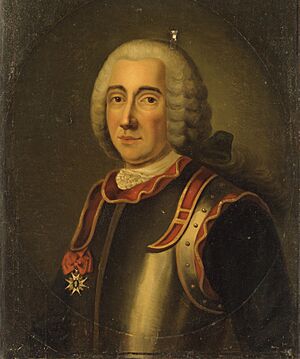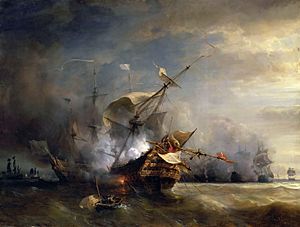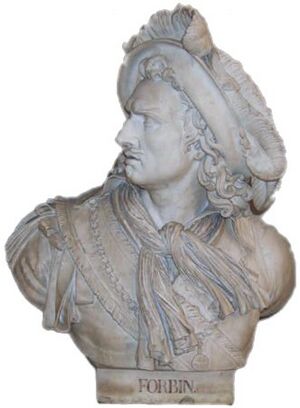Claude de Forbin facts for kids
Quick facts for kids
Claude, comte de Forbin-Gardanne
|
|
|---|---|

Portrait of Claude de Forbin by Antoine Graincourt, 18th century, Musée de la Marine.
|
|
| Born | 6 August 1656 Gardanne, Provence |
| Died | 4 March 1733 (aged 76) Near Marseille, France |
| Allegiance | |
| Service/ |
|
| Rank | Admiral |
| Battles/wars | |
Claude, comte de Forbin-Gardanne (born August 6, 1656, in Gardanne – died March 4, 1733) was a brave French naval officer. He was also a nobleman and a diplomat, which means he represented his country in other lands.
From 1685 to 1688, he went on an important trip to the Ayutthaya Kingdom, which is now part of Thailand. While there, he became the governor of Bangkok and even a general in the Siamese army. He left Siam just before the king, Narai, became sick and was removed from power.
Contents
Claude de Forbin's Life Story
Claude de Forbin was born in a village called Gardanne in Provence, France. His family had been important in Marseille since the 1300s. Claude de Forbin became the most famous person from his family's branch.
When he was young, Claude was very energetic and a bit wild. He ran away from home and, with help from an uncle, joined the French navy in 1675. For a short time, he left the navy and joined the king's special guards, called the musketeers. He got into a serious fight and faced big trouble, but he found a way to get back into the Navy.
He served under famous commanders like the Count d'Estrées and Duquesne. He fought in campaigns in America and Algiers (a city in North Africa). In every battle, he showed great bravery.
Becoming Grand Admiral of Siam
One of the most interesting parts of his life was his trip to Siam. At that time, a powerful minister named Constantine Phaulkon was in charge there. He wanted to bring new ideas and the Christian religion to Siam. So, the King of Siam sent a message to King Louis XIV of France.
In return, France sent its own group of representatives, called an embassy. Forbin went along with the Chevalier de Chaumont. Forbin was a major on their ship, the Oiseau. When Chaumont returned to France, Forbin was asked to stay and work for the King of Siam. He agreed, even though he wasn't sure at first. He became the grand admiral, a general of all the king's armies, and the governor of Bangkok.
While he was in charge, he helped stop a rebellion in Bangkok. It was a dangerous time, and he almost lost his life. However, the minister Phaulcon became jealous and tried to cause trouble for Forbin. After two years, Forbin couldn't stay there anymore. He left Siam and arrived back in France in 1688. Another officer, the Chevalier de Beauregard, took his place as Governor of Bangkok.
Fighting in Wars Against England
After his time in Siam, Claude de Forbin was very busy fighting in wars. First, he worked with another famous French sailor, Jean Bart, during a war with England. They were protecting a group of ships carrying supplies. When they were attacked by stronger enemy forces, Forbin and Jean Bart bravely fought to delay the enemy. This allowed the supply ships to escape.
Both Forbin and Jean Bart were captured and taken to Plymouth, England. But they were very clever! After only 11 days, they managed to escape. They crossed the English Channel in a small boat and were soon back serving France.
In June 1689, Forbin became a capitaine de vaisseau, which is like a captain in the navy. He commanded a ship called the Neptune in the Battle of Beachy Head (1690). After fighting in the North Sea in 1691, he commanded the Perle in the Battles of Barfleur and La Hogue. He was wounded in that battle. He also showed great courage at the Battle of Lagos (1693) in 1693. In 1695, he commanded the Marquis and sailed in the Mediterranean Sea and to Constantinople. In 1697, he helped in the siege of Barcelona in Catalonia.
During the War of the Spanish Succession, Forbin led a group of three large warships. He sailed in the Adriatic Sea, where he stopped ships from entering or leaving Venice. He also bombed Trieste and demanded money from Fiume. In 1703 and 1704, he hunted down enemy privateers (ships that attacked other ships for profit) from Vlissingen, Netherlands.
In June 1706, he attacked an English convoy and captured seven ships. On July 12, he took two Dutch ships. On October 28, he fought a strong Dutch convoy and captured three ships while sinking another.
In 1707, he was promoted to Chef d'Escadre, which is like a Rear-Admiral. On May 12, he captured a British convoy of 18 ships that were going to Portugal. Later that summer, he led his ship, the Mars, and a group of other ships into the White Sea. He returned to France on September 23 with 34 captured ships.

On October 21, in the Battle at The Lizard, he helped another French commander, René Duguay-Trouin. They almost completely destroyed an English convoy heading for Portugal. Out of 80 ships, they captured 60 merchant ships and four warships, and sank one more.
In 1708, Forbin helped Prince James Francis Edward Stuart travel to Scotland. This was an attempt to help the prince become the King of England. However, the plan was not well prepared, and it failed. After this, Forbin stopped sailing. He left the Navy in January 1715. He passed away on March 4, 1733, near Marseille.
His memories were written down by his secretary and published in 1730. Even though some people found him difficult because of his strong personality, Forbin is remembered as one of the most brilliant sailors of his time.
Six different ships in the French Navy have been named Forbin in his honor. You can learn more about them at French ship Forbin.
See also
- France-Thailand relations


